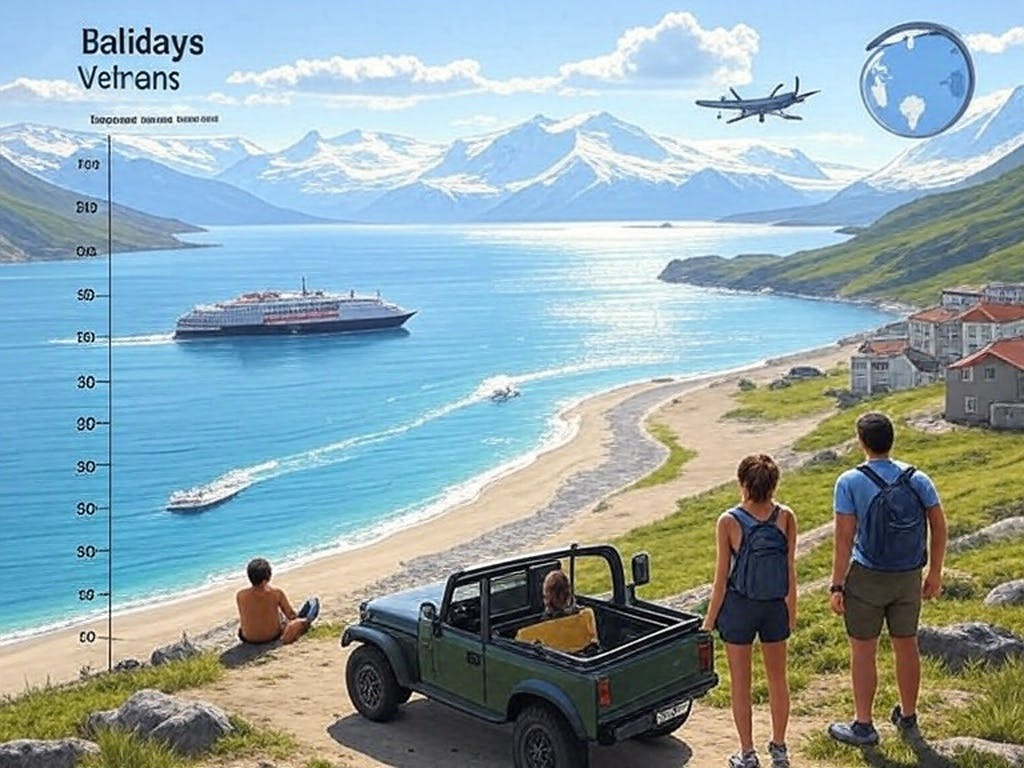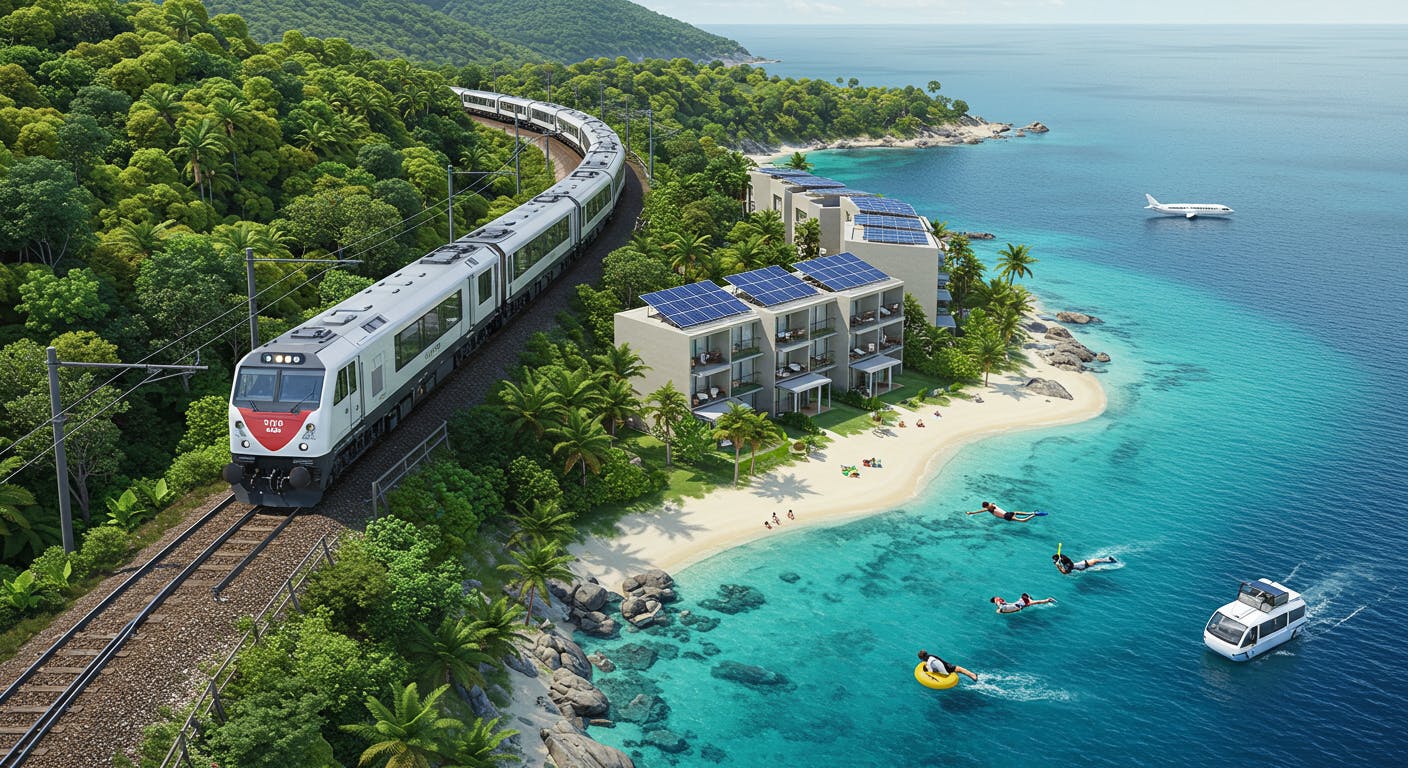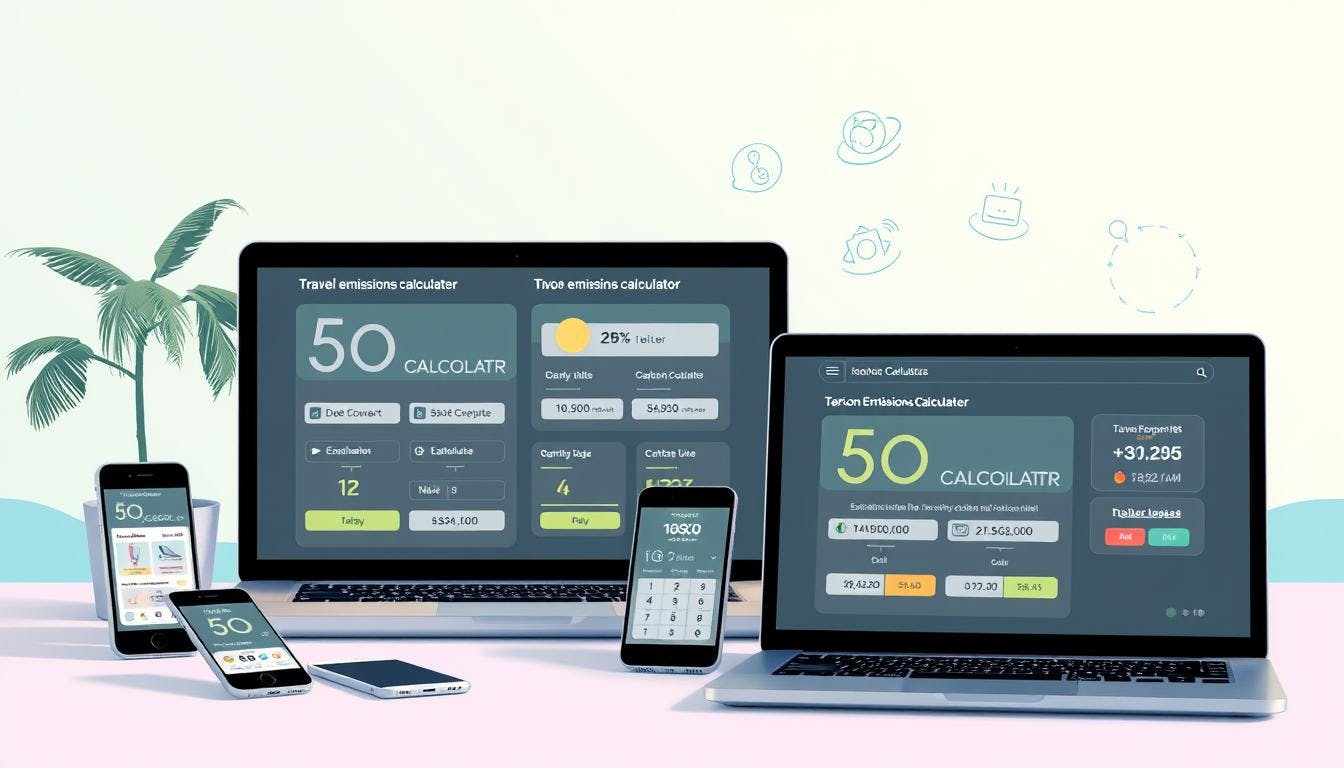Go the extra mile
Towards a cooler planet
Carbon footprint calculation for island vacations
29 April 2025
Tourism is responsible for around 8% of global emissions, with island getaways often having an even higher impact. Most of these emissions come from flights, places to stay, and getting around locally. Tracking them can help travellers make better-informed choices.
Flights usually make up the biggest share of a trip’s emissions, but energy use in hotels and activities like tours also add up. The Paris Agreement recommends that individuals keep their yearly emissions below 2 tonnes. The way most holidays are planned today often pushes people over that limit.
This guide looks at key factors like how far you fly, where you stay, and what you do once you arrive. It also shares simple tools and comparisons to help you lower your travel impact. To keep things clear, food-related emissions are not covered here.

Why calculate your island vacation’s carbon footprint?
Understanding the impact of your trip helps protect fragile ecosystems. Tourism accounts for around 8% of global greenhouse gas emissions, with some types of travel causing much greater harm than others. A seven-day holiday in Greece, for example, typically produces around 0.94 tonnes of CO₂ per person, while a Kenyan safari can generate about 2.2 tonnes.
Flights make up the largest share of emissions — around 74% of a safari’s footprint comes from air travel alone. Antarctic cruises are even more damaging, with each trip responsible for melting roughly 3.3 square kilometres of sea ice. These figures stand in stark contrast to the Paris Agreement’s call for individuals to stay under 2 tonnes of emissions per year.
Trips with lower emissions often turn out to be cheaper too. Some hotels, such as Hilton, are reducing their energy use by highlighting high-impact menu items to help guests make different choices. Families should be aware: a four-person trip to Disney can create as much as 8.6 tonnes of CO₂.
It is also important to watch out for misleading sustainability claims. Some resorts present themselves as low-impact without offering clear evidence. Reliable calculations give a true picture of your trip’s footprint and can help steer better decisions.

Step-by-step carbon footprint calculation for island getaways
Breaking down a trip’s emissions shows practical ways to cut them. Start by calculating the impact of flights, which often account for over 70% of total CO₂ output. Tools such as the ICAO Carbon Calculator estimate emissions based on distance, aircraft type, and passenger load.
Comparing different transport options reveals major differences. A flight to a US ski resort can emit around 2.3 tonnes of CO₂, while taking the train to the French Alps reduces this to just 0.1 tonnes. Sharing transport further lowers emissions per person.
Accommodation also matters. Hotels in Greece, for example, average around 15kg of CO₂ per night, mainly due to air conditioning demands. Stays certified for lower impact often use around 30% less energy.
Activities add to the footprint too. Safari vehicles can generate about 50kg of CO₂ per hour, while walking tours have a near-zero impact. Cruise ships vary widely — an Antarctic voyage can produce up to 8.4 tonnes of CO₂ per passenger, compared with about 0.84 tonnes for a Danube river cruise.
A simple way to estimate a trip’s emissions is: (Flight miles × 0.18kg CO₂ per mile) + (Hotel nights × 15kg per night). Using this, a seven-day Greek holiday totals roughly 0.94 tonnes of CO₂, with flights making up around 80% of the emissions.
Switching transport modes is one of the most effective ways to reduce emissions. Trains and coaches typically produce far less CO₂ than planes. Choosing destinations powered by cleaner energy grids can also make a significant difference.
Key factors affecting your carbon footprint
Many things affect how much CO₂ your trip puts out. Flight distance, where you stay, and what you do once you arrive all play a part. Small shifts in these areas can cut your emissions a lot.
Flights are the biggest factor. Flying from London to Rome puts out about 0.45 tonnes of CO₂. A trip from London to Nairobi pushes that up to around 2.2 tonnes. Shorter flights — or swapping to a train — cut this sharply.
Where you stay matters too. Hotels in Greece produce about 15kg of CO₂ per night, mostly because of heavy air conditioning. In France, hotel emissions are lower — about 30% less — because the electricity is cleaner.
Transport at your destination also makes a difference. Group tours in Jordan, for example, spread emissions across more people compared to private car hire.
When you travel matters as well. Busy seasons mean more energy use in hotels and airports.
What you do matters too. Safari jeeps pump out about 50kg of CO₂ every hour. Walking tours, by comparison, are almost zero-emission.
On cruises, the type of fuel is important. Ships burning heavy oil pollute far more than ones running on liquefied natural gas (LNG).
The way buildings are built plays a role as well. Hotels certified for energy efficiency, like those with LEED status, use less power than standard ones. Finally, the number of people sharing transport matters — full planes, trains, and buses spread emissions out, lowering the footprint per traveller.


How island vacations compare to other trips
Not all holidays have the same environmental impact. A seven-day Antarctic cruise, for example, emits 8.4 tonnes of CO₂, while a week-long holiday in Greece generates 0.94 tonnes. A hiking trip in Scotland produces just 0.09 tonnes.
The mode of transport makes a big difference. Flights are the major contributor. A trip to Disney World, for instance, leads to 2.15 tonnes of CO₂ per person, with 74% of that coming from air travel.
The destination also affects emissions. A ski trip in the US produces around 2.3 tonnes, while travelling by train to the French Alps lowers emissions to just 0.26 tonnes.
The level of luxury matters too. All-inclusive resorts use significantly more electricity than simpler options like camping.
River cruises are typically less impactful than ocean cruises, with a Danube river cruise emitting about 0.84 tonnes per person, compared to much higher figures for larger ocean vessels.
Kenya’s safaris have a high carbon footprint but contribute to conservation efforts. Shorter trips and choosing accommodation with clean energy sources can reduce your impact considerably.
Practical ways to reduce your island vacation’s impact
Small changes in travel habits can significantly reduce emissions from island trips. By focusing on transport and accommodation choices, you can lower your environmental impact without sacrificing enjoyment.
Transport strategies
- Offset flights: Programs like Cool Earth support rainforest protection projects to help offset emissions.
- Take trains: A train journey from Rome to Paris emits 0.1 tonnes of CO₂, compared to 0.45 tonnes by air.
- Pack light: For every 15lbs of luggage on long flights, you add another 0.1 tonnes of CO₂.
Lodging and Activities - Choose energy-efficient accommodation: Hotels certified under schemes like LEED use up to 30% less energy. Hilton’s carbon labelling highlights low-emission options.
- Opt for low-impact activities: Snorkelling has a much smaller environmental footprint than motorised watersports. Shared airport shuttles also reduce emissions by up to half per passenger.
Long-term solutions - Extend stays: Longer visits reduce the emissions per day compared to short trips.
- Rent locally: Renting gear locally helps avoid the carbon cost of shipping.
- Support sustainable aviation: Advocate for the use of sustainable aviation fuels in island regions.
These steps can align your travel with long-term sustainability goals while helping preserve destinations for future generations.


Tools and resources for accurate carbon footprint calculations
Specialised calculators make it easier for travellers to measure CO₂ emissions. The ICAO Carbon Calculator tracks emissions from flights based on distance and aircraft type. For example, a flight from New York to Bali emits 3.2 tonnes per passenger.
Hotels use the Hotel Carbon Measurement Initiative (HCMI) tool to assess energy consumption across properties. A Hilton in Hawaii might show 12kg of CO₂ per night, compared to 20kg at non-certified hotels.
Cruise ship emissions estimators also take fuel type into account. LNG-powered vessels reduce CO₂ emissions by 20% compared to those running on heavy oil. Activity calculators can help too. For instance, a walking safari produces 0.1kg of CO₂ per hour, while jeep tours contribute 50kg per hour.
Carbon labels, such as Hilton’s menu tags, highlight low-emission options. Always verify claims using GHG Protocol Scope 3 standards. Airlines like Delta and JetBlue support offset programmes that fund projects such as reforestation or solar energy farms.
Cornell’s Sustainable Tourism Index offers academic benchmarks for assessing the environmental impact of travel.
Note: Food-related emissions are excluded in this context for consistency with the methodology used by Source 2.
Making climate-conscious island travel choices
Smart travel choices can align your trips with sustainability goals while helping to preserve destinations. The Paris Agreement sets a 2-tonne annual CO₂ limit per person, making it crucial to rethink our vacation habits. Start by prioritising low-emission transport, such as trains over short-haul flights.
Hotels like Hilton offer 85% of their menu options with a lower environmental impact. Certification programmes, such as the GSTC (Global Sustainable Tourism Council), help identify sustainable operators. Kenya’s safaris, for instance, show how tourism can contribute to conservation funding.
Advocating for industry-wide changes is also key: support carbon-labelled packages and the adoption of cleaner aviation fuels. On a personal level, extending stays, packing light, and choosing environmentally certified accommodations can all make a difference. Together, these actions help reduce CO₂ emissions and protect fragile ecosystems.
17 South Street
Auckland 1010
New Zealand
info@carbonclick.com- -
- X
Sign up. Be inspired. Get clicking.
Subscribe now to stay up to date with CarbonClick, carbon offsetting and climate action.
By signing up you agree to our Privacy Policy.


